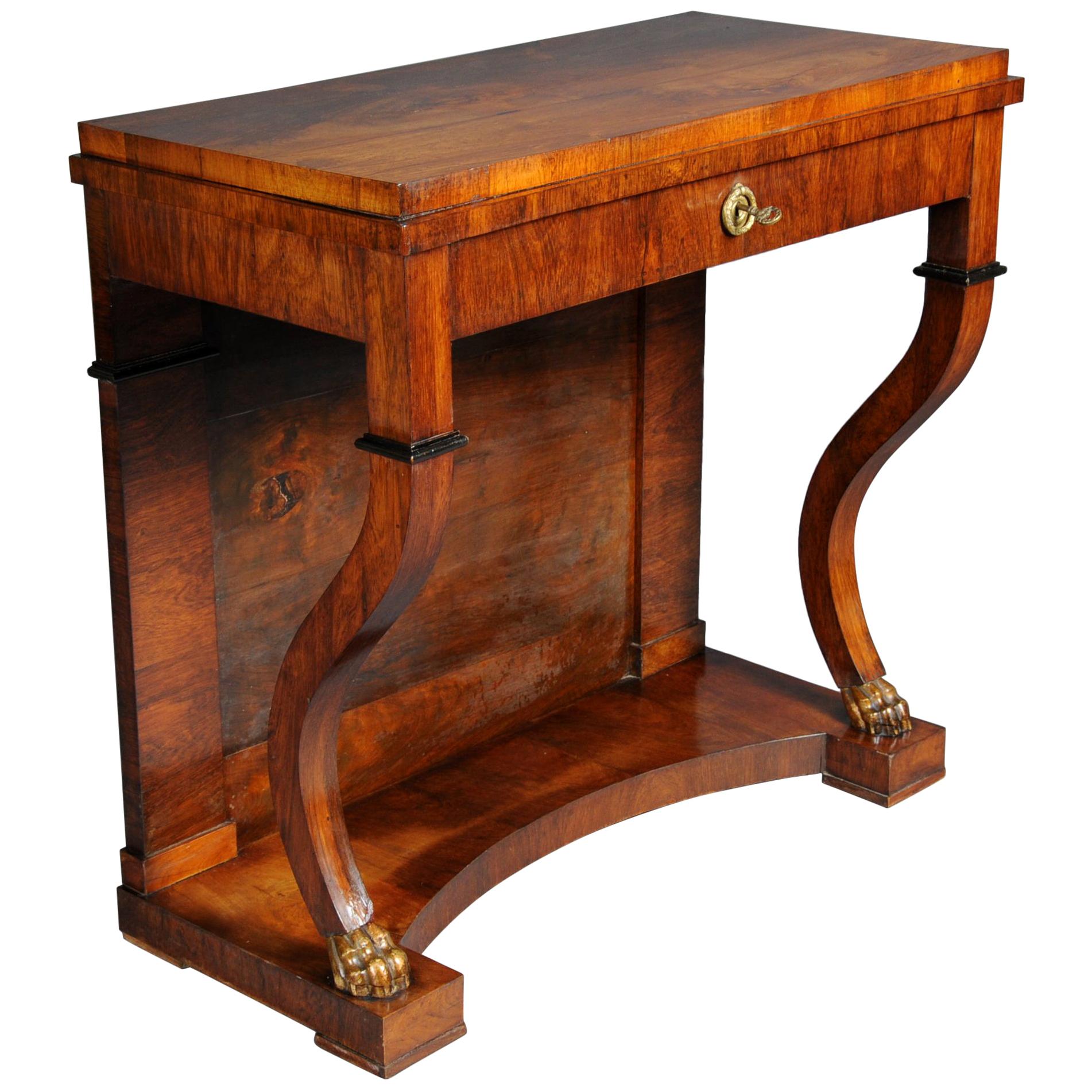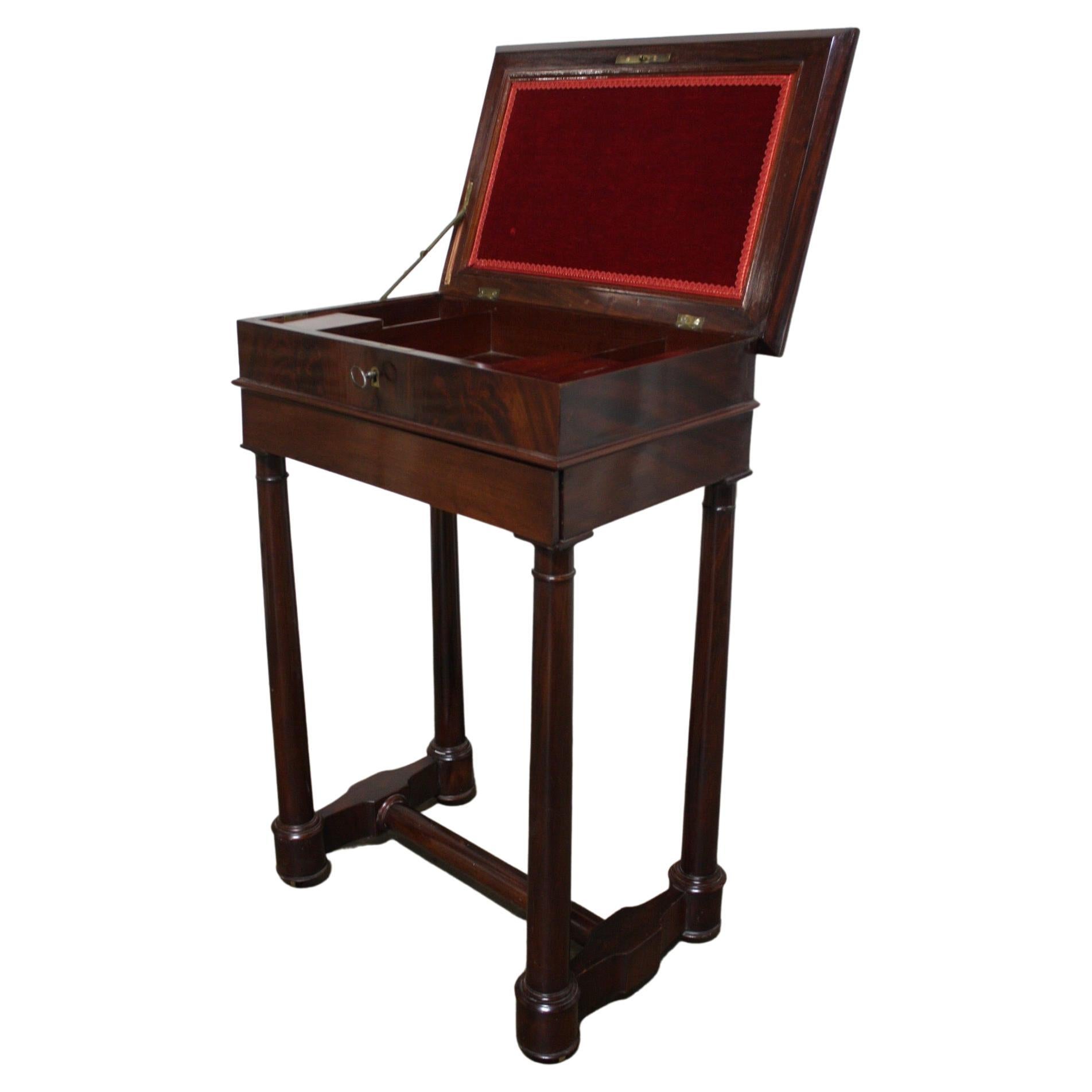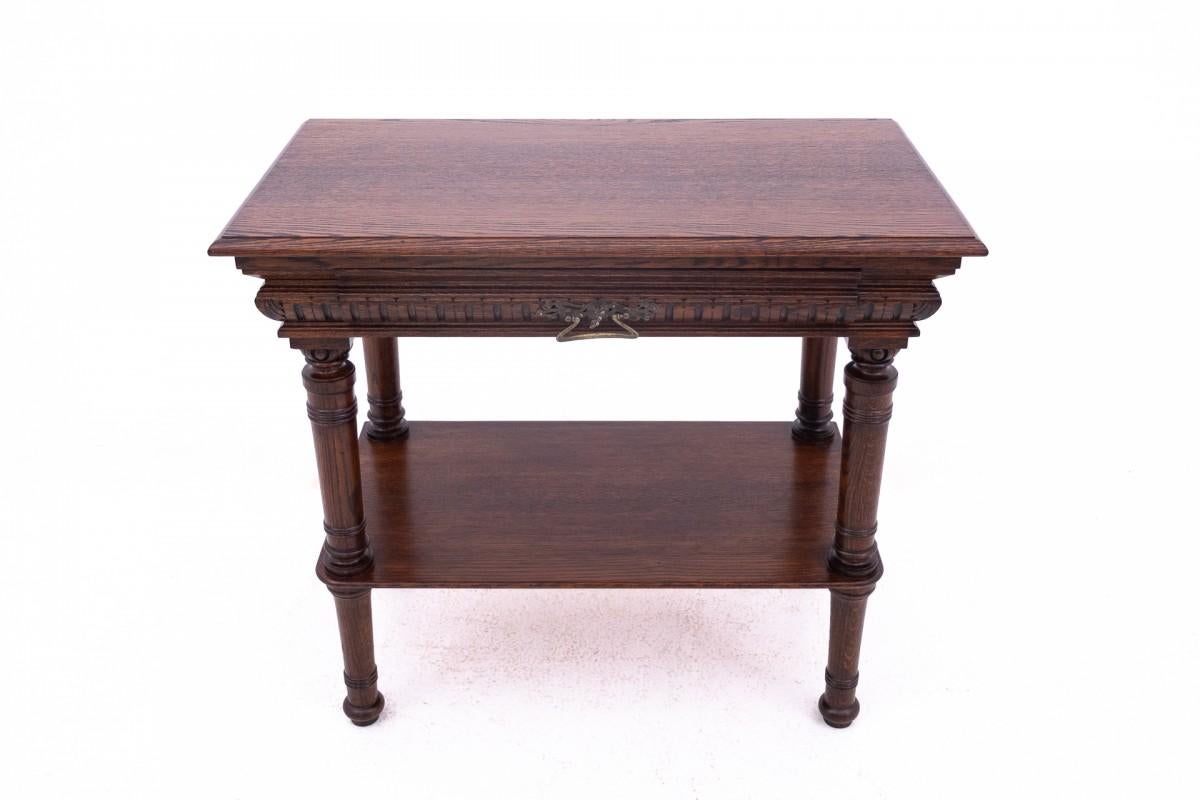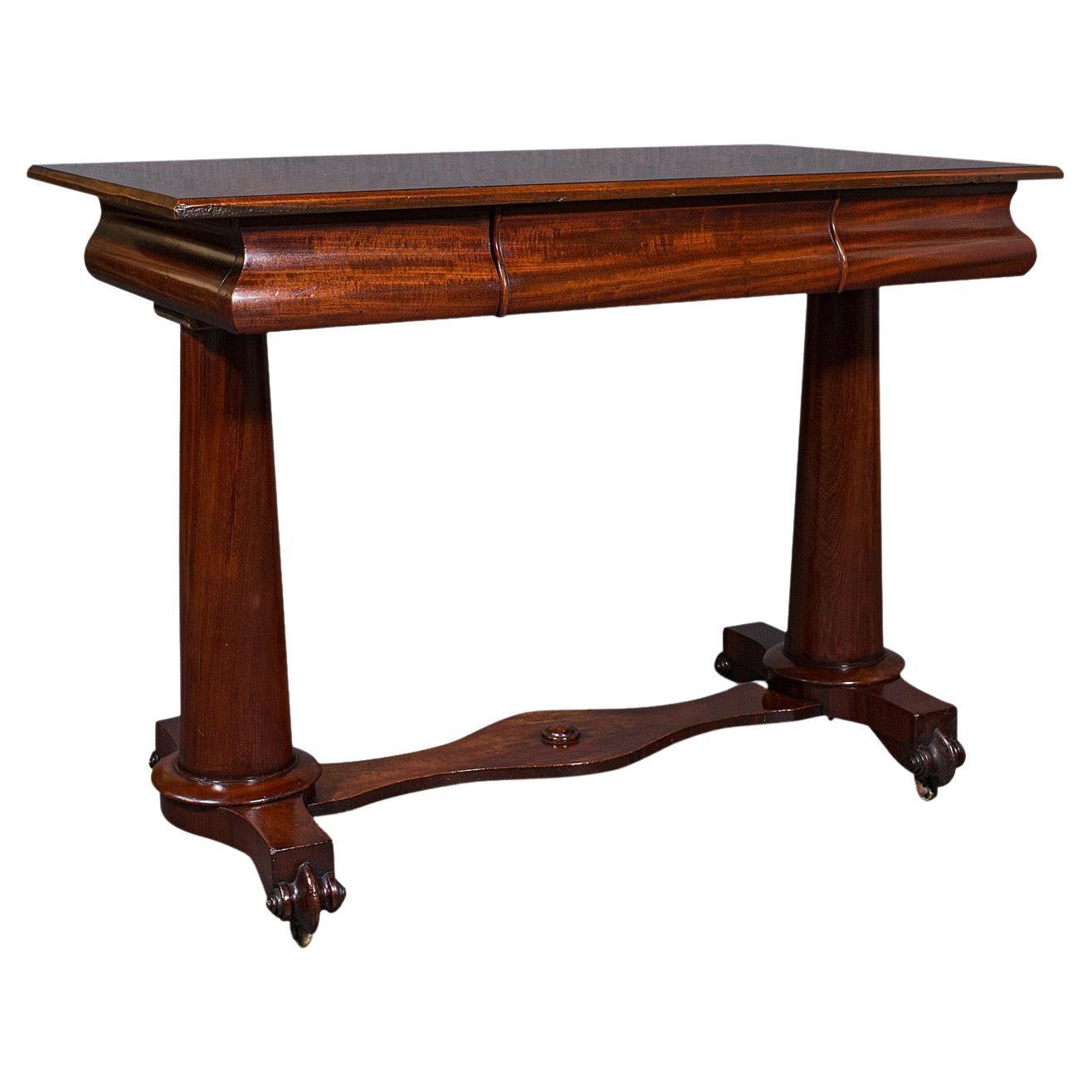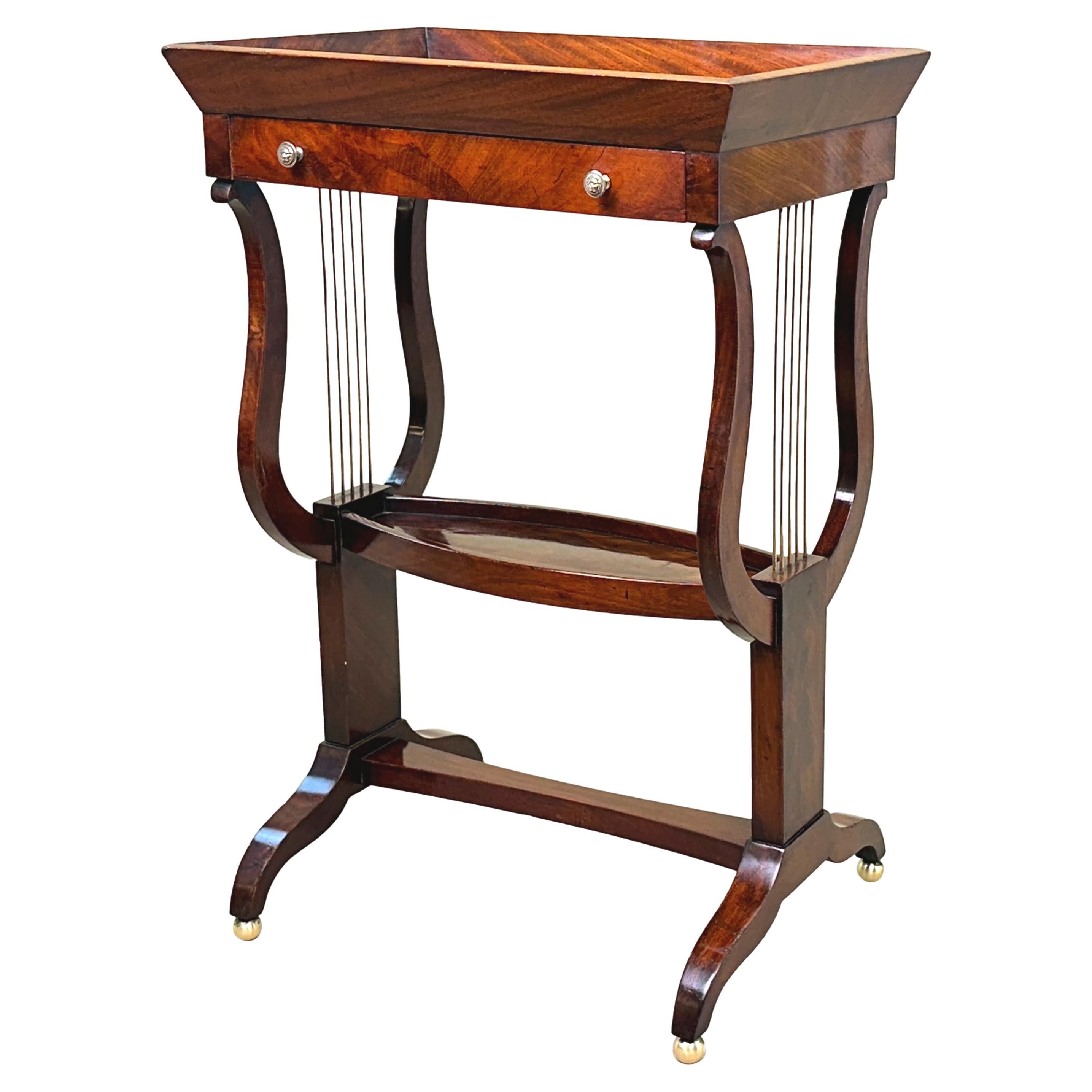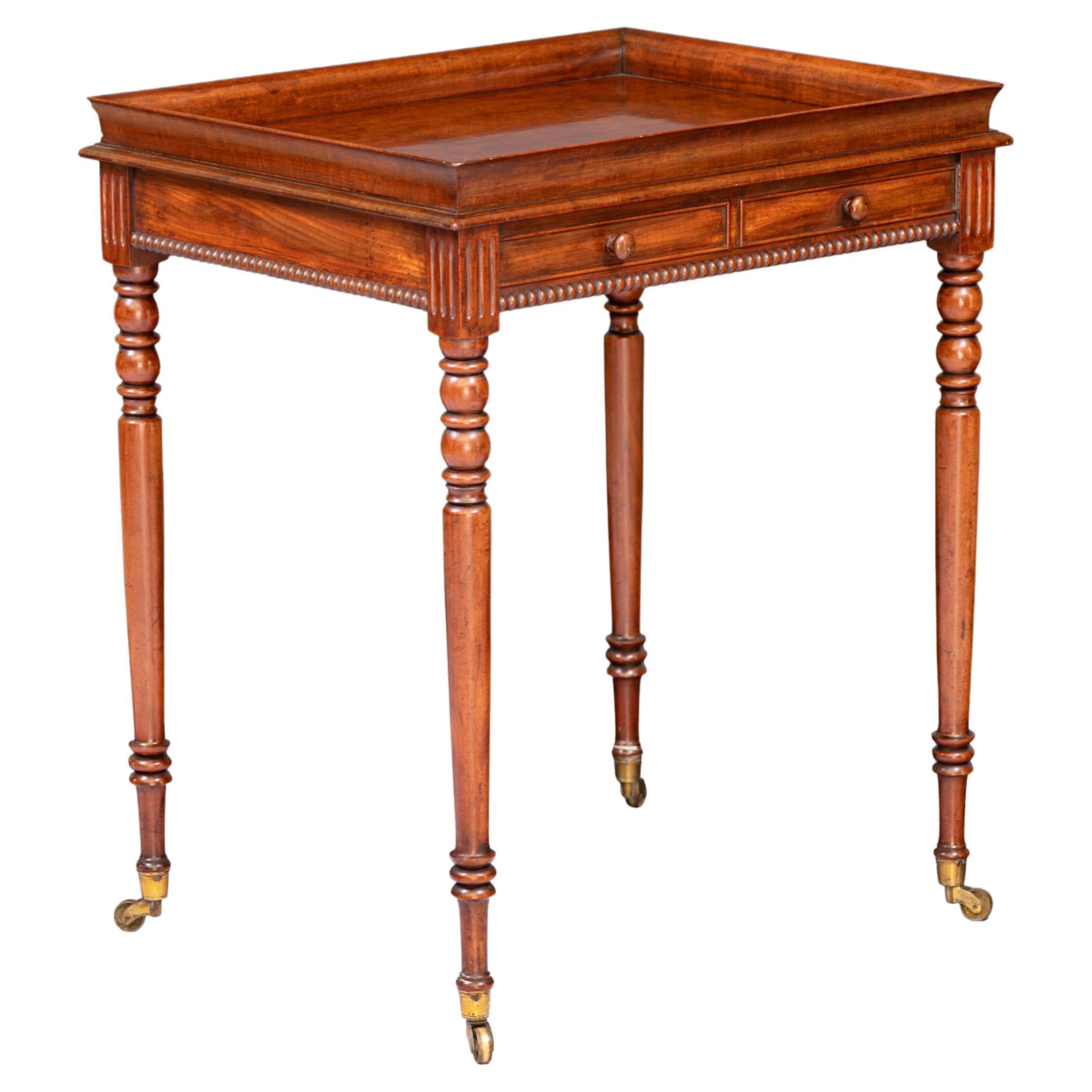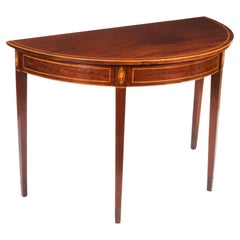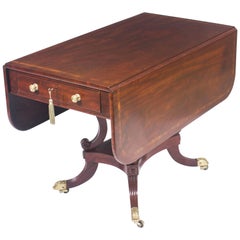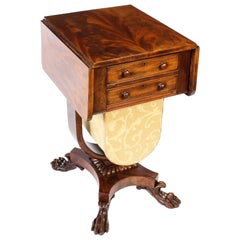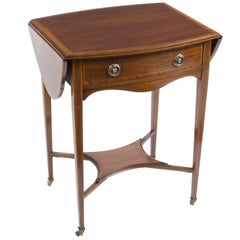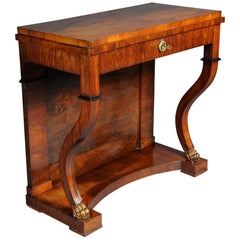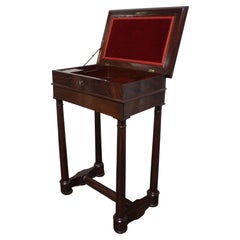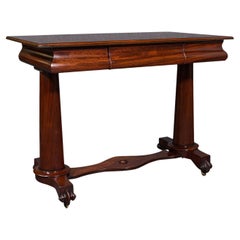Items Similar to Antique English Empire Console Writing Side Table, 19th Century
Want more images or videos?
Request additional images or videos from the seller
1 of 18
Antique English Empire Console Writing Side Table, 19th Century
$2,522.75
£1,850
€2,157.90
CA$3,485.39
A$3,800.45
CHF 2,016.86
MX$45,946.16
NOK 25,524.81
SEK 23,397.04
DKK 16,117.26
About the Item
This is a beautiful small antique English Empire Gonçalo Alves console with integral writing slide and pen drawer, circa 1820 in date.
This dual purpose table has a drawer above a pair of elegant tapering columns with gilded mounts to the top and bottom, behind them is a pair of rectangular columns framing a framed fabric slide that lifts up when required. This screen serves as a modesty / privacy screen.
This piece has a single drawer with a writing slide with its original olive green leather writing surface over a pen drawer that can be pulled out from the side of the drawer whilst the writing surface is in use.
This gorgeous console table will instantly enhance the style of one special room in your home and is sure to receive the maximum amount of attention wherever it is placed.
Condition:
In excellent condition having been beautifully restored in our workshops, please see photos for confirmation.
Dimensions in cm:
Height 73 x width 60 x depth 40
Dimensions in inches:
Height 28.7 x width 23.6 x depth 15.7.
Empire style,
is an early 19th century design movement in architecture, furniture, other decorative arts, and the visual arts followed in Europe and America until around 1830.
The style originated in and takes its name from the rule of Napoleon I in the First French Empire, where it was intended to idealize Napoleon's leadership and the French state. The style corresponds to the Biedermeier style in the German-speaking lands, Federal style in the United States and to the Regency style in Britain. The previous style was called Louis XVI style, in France.
The Empire style was based on aspects of the Roman Empire. It is the second phase of Neoclassicism which is also called "Directoire", after a goverment system.
Furniture typically had symbols and ornaments borrowed from the glorious ancient Greek and Roman empires.
The furniture was made from heavy woods such as ebony, imported from the colonies, with dark finishes often with decorative bronze mounts. Marble tops were popular as were Egyptian motifs like sphinxes, griffins, urns and eagles and the Napoleonic symbols, the eagle, the bee, the initials "I" and a large "N."
Gilded bronze (ormolu) details displayed a high level of craftsmanship.
- Dimensions:Height: 28.75 in (73 cm)Width: 23.63 in (60 cm)Depth: 15.75 in (40 cm)
- Style:Empire (Of the Period)
- Materials and Techniques:
- Place of Origin:
- Period:
- Date of Manufacture:circa 1820
- Condition:
- Seller Location:London, GB
- Reference Number:Seller: 096161stDibs: LU950615727371
About the Seller
5.0
Platinum Seller
Premium sellers with a 4.7+ rating and 24-hour response times
Established in 1983
1stDibs seller since 2012
1,440 sales on 1stDibs
Typical response time: <1 hour
Associations
LAPADA - The Association of Arts & Antiques Dealers
- ShippingRetrieving quote...Shipping from: London, United Kingdom
- Return Policy
More From This Seller
View AllAntique George III Demi Lune Console Side Hall Table 18th C
Located in London, GB
This is a superb antique flame mahogany and chequer strung demi-lune console table, Circa 1780 in date.
This splendid console table is made of the finest quality flame mahogany a...
Category
Antique 1780s English George III Console Tables
Materials
Mahogany
19th Century Regency George III Pembroke Table Gillows
Located in London, GB
This wonderful antique pembroke dining table is unmistakable in sophistication and style dating from the Regency period, circa 1820, and ...
Category
Antique 1820s English Regency Tables
Materials
Mahogany
Antique William IV Drop-Leaf Work Occasional Table Flame Mahogany, 19th Century
Located in London, GB
An exquisite antique William IV flame mahogany drop leaf work table, circa 1830 in date.
The drop-leaf top with rounded corners supported by fly brackets ornamented with foliate scr...
Category
Antique 1830s English William IV Tables
Materials
Mahogany
Early 20th Century Edwardian Inlaid Occasional Table
Located in London, GB
This is a delightful antique Edwardian mahogany and inlaid and crossbanded occasional table, circa 1900.
This is a drop-leaf table which has a useful drawer with two brass handles. ...
Category
Antique Early 1900s English Edwardian Side Tables
Materials
Mahogany
Antique Victorian Mahogany Console Hall Table, 19th Century
Located in London, GB
This is a gorgeous antique English Victorian mahogany console table, circa 1860 in date.
This graceful console table has a useful fri...
Category
Antique 1860s English Victorian Console Tables
Materials
Fabric, Mahogany
Antique Victorian Mahogany Demilune Card Console Tea Table, 19th Century
Located in London, GB
This is a beautiful antique Victorian mahogany demi lune side table, 19th century in date.
The table is made of solid mahogany with a moulded top above a plain frieze and is raised ...
Category
Antique 1850s English Victorian Card Tables and Tea Tables
Materials
Mahogany
You May Also Like
Antique Empire Console /Sideboard, around 1810
Located in Berlin, DE
Solid wood with veneer, partly gilded. Rectangular cover plate with an inconspicuous frame and S-shaped curly supports on carved claws, which are held in gold. The base is arched. Pa...
Category
Antique Early 19th Century French Empire Console Tables
Materials
Mahogany
Late 19th Century Empire Style Side Table
Located in Stockbridge, GA
Late 19th century Empire style jewelry side table.
Category
Antique Late 19th Century French Empire Side Tables
Materials
Mahogany
Console - side table, Western Europe, late 19th century.
Located in Chorzów, PL
Antique console - table from around 1890, Fracnja.
Furniture in very good condition, after professional renovation.
Dimensions: height 85 cm / width 95 cm / depth 52 cm
Category
Antique Late 19th Century Unknown Neoclassical Side Tables
Materials
Walnut
Antique Console Table, English, Side, Occasional, Writing Desk, Regency, C.1820
Located in Hele, Devon, GB
This is an antique console table. An English, rosewood and mahogany side or occasional table, dating to the Regency period, circa 1820.
Of superior, striking craftsmanship and fin...
Category
Antique Early 19th Century British Console Tables
Materials
Wood
Early 19th Century Mahogany Tricoteuse Occasional Table
Located in Bedfordshire, GB
An Extremely Elegant Early 19th Century, French Empire Period, Mahogany Tricoteuse Type Occasional Table, Having Extremely Well Figured Rectangular Galleried Top, Over One Drawer To ...
Category
Antique Early 19th Century French Empire Tray Tables
Materials
Mahogany
Early 19th Century English Regency Side Table Attributed to Gillows of Lancaster
By Gillows of Lancaster & London
Located in Dublin, IE
A fine Regency mahogany occasional table attributed to Gillows of Lancaster, with tray top above frieze drawers and beaded border, on turned tapering legs with castors.
Circa 1828
...
Category
Antique Early 19th Century English Regency Tray Tables
Materials
Wood
More Ways To Browse
Goncalo Alves
Ancient Greek Furniture
Louis Xvi Small Console Tables
Egyptian Urn
Pair Of Federal Console Tables
Pair French Bronze And Marble Tables With Eagles
French Louis Xv Giltwood And Marble Console Table
French Marble Top Wall Mount Console Table
Italian Tuscan Table
Pair Glass Console
Rounded Console Table
Wooden Marble Table
2 Leg Console Table With Drawers
Black Gold Console
French Green Marble Iron Table
Greek Key Frieze
Pink Marble Dining Table
White Oak Entry Table
